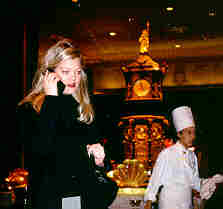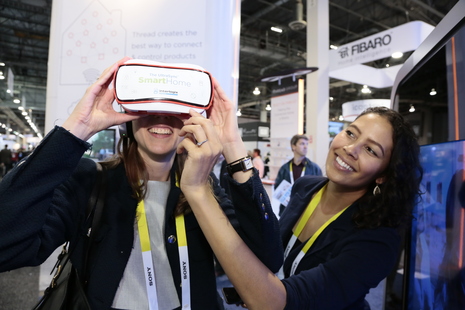By Les Spielman
REVOLUTION: The world is poised for explosive changes in telecommunications. “It’s going to be kaboom,” one observer says.
A cloud as big as Montana coasts drowsily over the right-field bleachers as you watch a relief pitcher amble in from the bullpen. It seems like a good time to check in at the office. Balancing a laptop computer on your knees, you dial in on your cellular phone, log onto the computer network and check your E-mail messages. You read the latest news from the Associated Press, check some stock prices, get your phone messages and troll the Internet before you sign off. Just in time. The new pitcher has warmed up and the hitter steps in. Put down the laptop and pick up your score card.
This isn’t the future–it happened in Baltimore. And a few years from now, two-handed juggling of a cellular phone hooked to a laptop computer will seem crude.
The world is poised at the brink of a telecommunications revolution, and change will come with the magnitude of the invention of the automobile, the electric light and the printing press. Or, as Pacific Telesis Chairman Phil Quigley says, “It’s going to be kaboom.” Millions of Americans will carry pocket-sized “personal communicators” that will combine the capabilities of computers and telephones in one mobile gadget. The communicators will become fax machines, calendars, address books and sketch pads with the insertion of function modules the size of a credit card.
A large percentage of people will have a personal telephone number that they can be called at wherever they travel in the world. At home, the wireless personal communicator will automatically connect with the wired communications system that effectively merges the telephone, television and computer into one instrument. Computers will speak and understand English, handling by voice many of the commands that today must be typed. Pocket phones may even include components called “personal digital assistants,” tiny computers that make calls, take and deliver messages and do many tasks that secretaries now do. They will perform wherever you are, even in a moving car.
Two-way video phones may be as common as speaker phones, or even cordless handsets, are now. Some people may prefer “wearable technology,” telephones as small as tie clips or earrings that are more convenient and less obtrusive than cellular phones. And it won’t be only the elite that can take advantage of all this technology–“yuppie toys,” as one phone company executive has dubbed them. In nine years, projects a study by the Personal Communications Industry association., more than 52 million Americans will have cellular phones and 31 million will have phones using a new digital wireless technology called personal communications services, or PCS. And 65 million people will have pagers or messaging services. The social implications are enormous.
“We may begin to see spatial organizations of human settlement quite unlike the classical city; threats to freedom of speech and of the press; erosion of the sovereign state, and a fracturing of society’s cohesion,” said the late Ithiel de Sola Pool, a telecommunications visionary. Others believe the revolution will empower people to take more control of their lives, be less passive and overcome for the first time in human history limits of mobility, sense perception and the difficulties of the human-machine interface. Which way will it go? Will the gulf between rich and poor be widened by a new divide between the knows and the know-nots? Or will it be bridged by more information in the hands of everyone? Will society become even more fragmented as people delve further into their specialized fields and social interaction changes from personal to electronic? Or will the global village become something more meaningful than watching televised images of famine in faraway lands?
Will conventional literacy shrivel, leaving those with traditional deductive skills behind those with a new kind of visual literacy? Or will we see a broader and brighter definition of intelligence? Will the technology be driven by a few monopolies? Or spawn a new era of competition and entrepreneurship? The questions–and these are only a few–are fundamental. Some shifts have already begun. Fifteen years ago, the fastest growing segment of the American economy was in low-level service jobs, such as fast-food workers, a phenomenon that raised concerns about the economy’s health. Today information-related jobs are setting the pace. We are spending more time and money communicating and sifting information. In 1984, the average American household spent $1,000 a year on telecommunications. Today, adjusted for inflation, that expenditure has doubled.
If the numbers seem surprising, consider this: Cellular phones were introduced as a luxury in 1983. By 1993, 13 million Americans used them. In a matter of months, moreover, there will be a major breakthrough in wireless phone technology when the federal government opens new frequencies in the wireless spectrum, tripling the amount of airwaves for wireless and ultimately driving the introduction of digital wireless technology. This PCS technology will handle five to 10 times more calls or channels than cellular and cost half as much. Within the last three years alone, as McCaw Cellular Chairman Craig McCaw put it recently, “Change is occurring at a rate faster than even the most extreme techie would have dreamed.”
Three forces are driving this revolution.
- Advances in microelectronics, the art of putting computing power into small spaces by adding transistors on chips made of sand. There are already more microprocessors (computers on a chip) than there are people on Earth. Now, the power of each chip is doubling every 18 months without increasing the price.
- Fiber optics, the science of shooting laser beams as small as grains of sand through glass fibers as thin as strands of hair. A year ago fiber-optic lasers could transmit about 3.4 billion bits of data per second, or 50,000 phone conversations on a pair of fibers. Soon, experts expect to send 1 trillion bits per second, or 70 million conversations. These digital phone lines are what will make the 1,000+ channel TV set or two-way video phones possible.
- Digital wireless phone technology, using satellites and new high-band frequencies in the air to move phone data. Wireless phones will be greatly improved at nearly the same cost as wired communications. Until now, computers had intelligence, but it was cumbersome to connect them. Phones had connectivity, but they were basically dumb. Wireless devices offered mobility but weak transmission quality. As the three technologies evolve, the virtues of each are merging. AT&T is already offering what it calls the “virtual office” package, in which workers can trade their commute and work space for a mobile phone, portable computer, printer and modem. More than 500 AT&T salespeople have operated this way, and the company is now selling the gear–weighing 6.5 pounds–to others.
Whether this becomes more than a fad will depend on human behavior. But coming technology will clearly make the limits of spatial geography less important. Cellular phones today offer people local and even national mobility. By 1997 or “98, low-orbit satellite systems will make wireless phone mobility global. Motorola’s Iridium project, which will cover even the remotest parts of the world through 66 low-orbit satellites, is scheduled to begin in 1998. Even more ambitious, Teledesic Corp., a joint venture of Bill Gates’ Microsoft and McCaw Cellular, plans a system involving 840 satellites by 2001.
The new PCS technology–digital wireless phone frequencies–will further reduce costs and allow people to move inside and outside buildings, says Ben Gavis, a professor of management at Vanderbilt University in Nashville, Tenn. In perhaps less than 10 years will come the wireless phone of the future, the personal communicator. It will be a computer, a phone, a fax machine and more–pocket-sized. It will carry one’s calendar and address book. If two people meet and want to exchange phone numbers, they may be able to simply aim their communicators and “squirt” (no sexual puns intended) the information to each other with an infrared signal, says Philip Evans, director of telecommunications planning at Perot Systems. This pocket phone computer will also involve a “personal digital assistant,” which will take voice commands and handle various daily activities. Just tell it what to do: “Call the office and tell them I am running late. Then get my messages and call my next appointment.” The wireless phone will probably work in several media, says Quigley, the new chairman of Pacific Telesis Group, the holding company of the Pacific Bell companies. It will look for a cellular link first, then switch to satellite or to PCS networks. And when someone arrives home, calls can be automatically switched to the wired system of the house.
The consequences of all of this are probably beyond the reach of most of us to imagine. Vanderbilt’s Gavis predicts, as many others do, that corporations and other institutions will fire many of their managers. With more sophisticated communications, a single manager can supervise many more employees. Corporations will become smaller and less hierarchical. But will the displaced managers become entrepreneurs or unemployable? Thinkers worry about solitude. “It’s going to be hard to disappear,” says John Fike, director of the Center for telecommunications at Texas A&M University. If people work in virtual offices, communicating by E-mail, what happens to human interaction? That has given rise to the concept of the “virtual water cooler”– using video phones to help people maintain office camaraderie and keep up with gossip.
But there’s an obverse view. Most people involved in the industry have a passionate faith that the technology will empower people. On a simple level, George Gilder believes people’s relationship to their phones will no longer be so passive. We get up in the middle of dinner and answer and let it invade our lives in all sorts of ways. “As time passes, the people receiving calls will abandon these old practices,” says Gilder, an influential technology writer. They may choose to monitor the calls without answering; or know whether it is a business, personal or other kind of call by the ring; or have a video readout that tells them who is calling. Or they may simply push a button that messages that they will call back.
Others ponder the division between knows and know-nots, and some say it is generational and will gradually disappear. Some also wonder about the impact on the way people think. Fike at Texas A&M says his students today have much more information than students a generation earlier. “But when it comes to their reading skills, their ability to read something for content, they have a hard time.” Gilder is not so worried. Text, he believes, will always be primary to civilization. The computer, not television, will be the center of this revolution. Learning, not entertainment, will be central.
Do you know what?………….They are all guessing!!

 devices, especially tablets and smartphones, have become so central to consumers’ personal and professional lives that hoteliers are taking notice, with checkbooks in hand, ready to buy solutions that drive their mobile strategies and deliver results.
devices, especially tablets and smartphones, have become so central to consumers’ personal and professional lives that hoteliers are taking notice, with checkbooks in hand, ready to buy solutions that drive their mobile strategies and deliver results.
